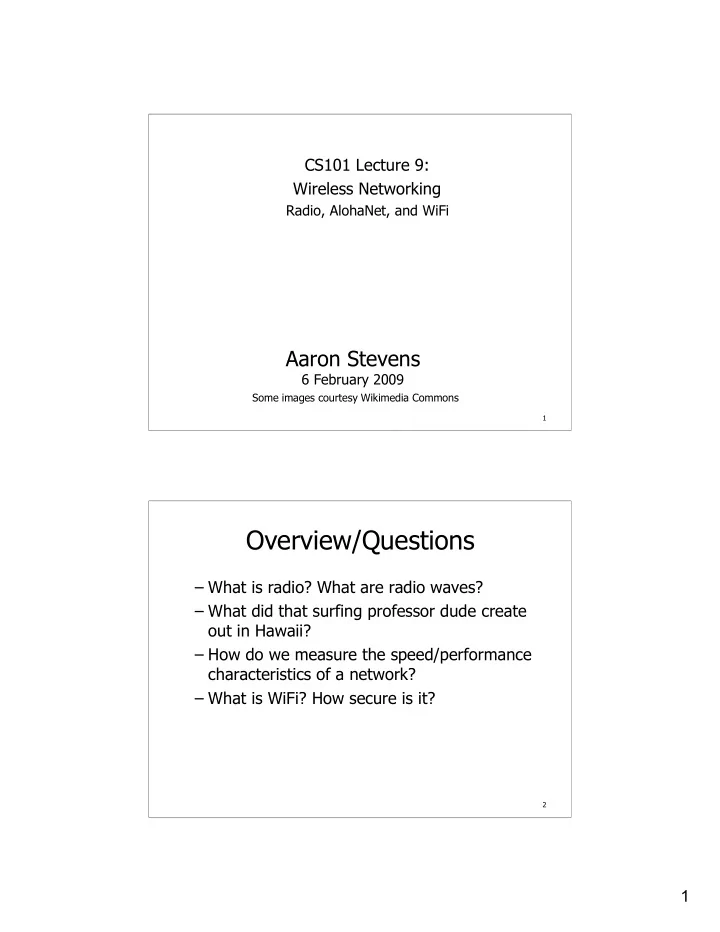

CS101 Lecture 9: Wireless Networking Radio, AlohaNet, and WiFi Aaron Stevens 6 February 2009 Some images courtesy Wikimedia Commons 1 Overview/Questions – What is radio? What are radio waves? – What did that surfing professor dude create out in Hawaii? – How do we measure the speed/performance characteristics of a network? – What is WiFi? How secure is it? 2 1
What is Radio? Radio waves are electromagnetic radiation, which travel trough the air. Wave length is length (e.g. in meters) of a radio wave. Frequency is the number of occurrences of a repeating event per unit time. 3 – Cycles per second, called Hertz. Electromagnetic Spectrum AM radio waves are about 100 meters FM radio/TV waves are about 1 meter Light waves are about 0.000005 meters 4 2
How Radio Works Radio transmissions are sent from a transmitter to a receiver. – Transmitter usually has a high- powered antenna; receiver usually uses low power antenna. – Limited by power, line of sight Most wireless data is sent via radio waves including “radio”, television, cell phones, WiFi, and Bluetooth. 5 Recall: Aloha Net Norm Abramson first demonstrated wireless packet switching with the AlohaNet, circa 1970-1972. – Originally sender/receiver used different frequencies. – Later, multiple senders/receivers shared one frequency. 6 3
Lessons from AlohaNet – Many transmitters/receivers shared one medium (radio frequency). – Limited efficiency because of blocked packets. – Let to the creation of “carrier sense multiple access/collision detection” -- CSMA/CD Used by Ethernet, WiFi 7 Talking about Numbers Many educated people have little grasp for very big or very small numbers. – A million is 1,000,000 – A billion is 1,000,000,000 – A trillion is 1,000,000,000,000 Scientific Notation is clearer and easier to work with, and we’ll often use it in CS101. 8 4
Scientific Notation There’s nothing very tricky about it! 10 N is 1 with N zeros after it: 10 3 is a thousand, or 1,000 10 6 is a million, or 1,000,000 10 9 is a billion, or 1,000,000,000 10 12 is a trillion, or 1,000,000,000,000 Example: 4 X 10 9 is 4,000,000,000 9 Scientific Notation There’s nothing very tricky about it! 10 -N is 1 divided by 10 N : 10 -3 is a thousandth, or 0.001 10 -6 is a millionth, or 0.000001 10 -9 is a billionth, or 0.000000001 10 -12 is a trillionth, or 0.000000000001 3.4 X 10 -7 is 3.4 X 1/10000000 or 0.00000034 10 5
Sizes in Perspective Sizes used in describing computer stuff: We’ll discuss power of 2 numbers next time 11 Order of Magnitude The order of magnitude compares the relative size of numbers. Examples: giga (10 9) is 1000 times bigger than mega (10 6 ) micro (10 -6) is 1000 times smaller than milli (10 -3 ) 12 6
Ethernet – Ethernet developed at Xerox PARC in 1973-75 Used CSMA/CD Speeds up to 3 Mbit/sec – IEEE 802.3 standard (1983) was 10 Mbit/sec Later, speeds of s100Mbit, and 1000Mbit (1 Gbit) have come to market. Bits: 1s or 0s of digital communication. BitRate: how many bits can be sent per second. 13 WiFi Ethernet “WiFi” is only a trade name for IEEE 802.11 Left: an IBM laptop with built in WiFi, and a Linksys wireless access point; Right: a municipal wireless access point. 14 7
Comparing WiFi Generations – BitRate: how many bits can be sent per second. – Note the frequency of WiFi is in the GHz range. by contrast, AM radio is in the KHz range; FM radio is in MHz range. 15 WiFi Limitations The popular 802.11g uses the 2.4 GHz frequency spectrum, which is crowded: – microwave ovens, Bluetooth devices, baby monitors, (in the USA) digital cordless telephones operate on this frequency 5GHz (802.11a) isn’t as crowded, but the smaller wave length is more easily absorbed by walls/structures. 16 8
WiFi Security (NOT) WiFi is a BUS network -- every node is communicating on the same frequency. Example… 17 Securing your (wireless) data The main strategies for securing data sent via WiFi involve encrypting the data. – Wireless Protected Access (WPA) -- encryption between host and wireless access point. – Virtual Private Network (VPN) -- encryption between host and remote VPN server. 18 9
Take-Away Points – Radio waves, frequency, wavelength – AlohaNet, CDMA/CD – Talking about big/small numbers – Bitrates – Ethernet – WiFi 19 Student To Dos – HW04 due Tuesday 2/10 – Readings: http://en.wikipedia.org/wiki/Wi-Fi (today) http://en.wikipedia.org/wiki/Radio_waves (today) Reed ch 5, pp 83-87 (next week) 20 10
Recommend
More recommend